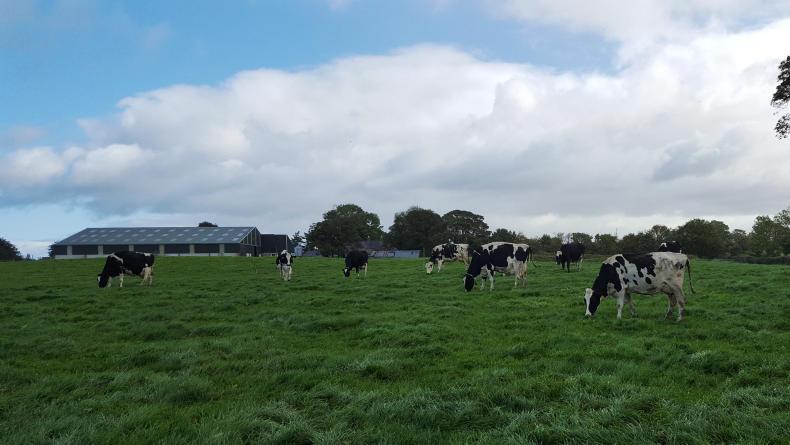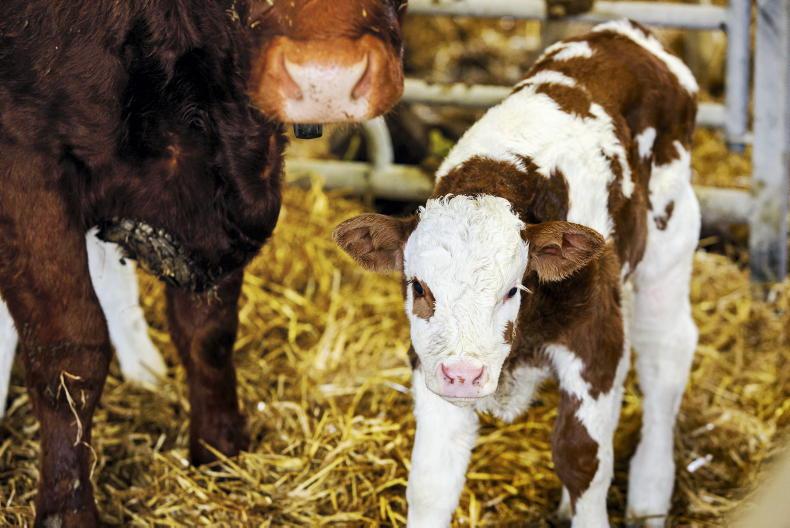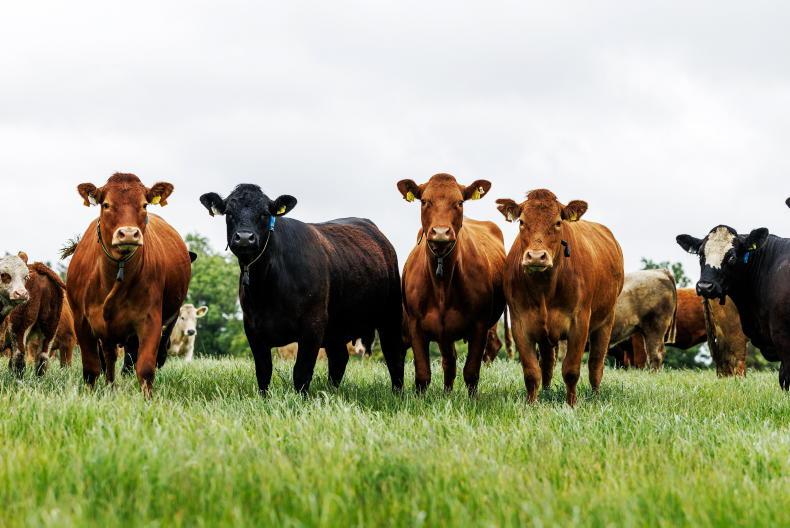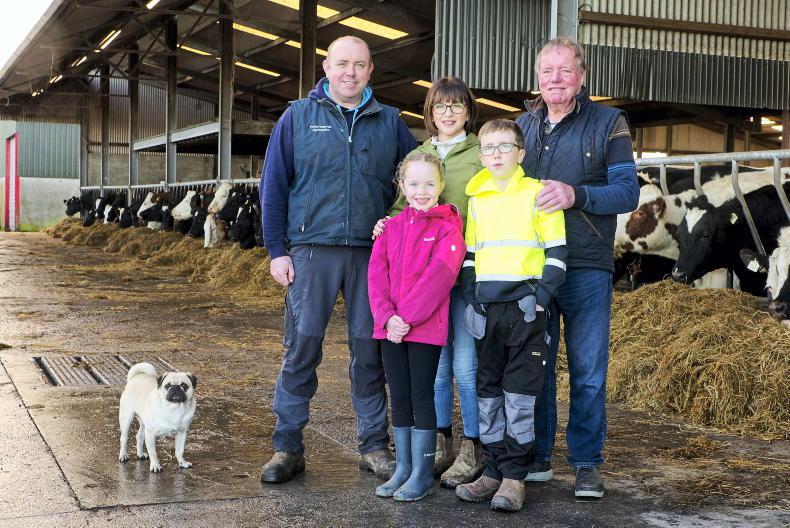A significant amount of purchased feed has been displaced with home-grown forage over the past three years on Nigel Corbett’s farm near Banbridge, Co Down.
As Table 1 outlines, concentrate feed levels have reduced by 22% and milk yield per cow last year was at a similar level to when Nigel started the Dairylink Ireland programme in 2015. Milk from forage is up by over 1,000 litres/cow in the three-year period to 3,081 litres/cow last year.
In 2017, annual grass growth stood at 11.2tDM/ha on Nigel’s grazing block, up from 9.4tDM/ha the year previous, and progress has been made in making more use of this extra feed.
Key steps taken to grow and utilise more grass on the Corbett farm included addressing deficiencies of lime, phosphorus and potassium in soils, weekly grass measuring, reseeding, constructing laneways for improved access to the grazing platform and opening multiple entry points to paddocks.
A new parlour and winter accommodation had been built before joining the programme in 2015, so with investments complete in the yard, the focus for Nigel was on developing the grazing platform to get more milk from grass.
Costs
This has allowed production costs to reduce on the Corbett farm. As Table 2 shows, farm working expenses were over 2p/l lower last year than at the start of the programme. Funding of capital investments from cashflow in 2016 explains the initial increase in working expenses. A loan taken out later in 2016 to fund capital expenditure has allowed total working expenses to reduce and cash to be set aside for the next downturn in milk prices.
The significant increase in net cash in 2017 is down to lower production costs and a significant up turn in milk prices. Average annual milk price in 2016 was 20.85p/l, compared to 27.11p/l last year.
When milk price fluctuations are removed by applying a standardised milk price of 25p/l to Nigel’s financial data over the three-year period, the net cash generated has increased by over 3p/l during the programme.
Improvements in breeding and fertility
Cow numbers and stocking rate have increased on the Corbett farm over the past three years, with Nigel set to milk 110 cows next year at a milking platform stocking rate of 2.59LU/ha. This compares with 87 cows and a 2.04LU/ha stocking rate in 2016.
A key aim for the Corbetts during the project has been to tighten the calving spread and move towards a block autumn-calving system, but increasing cow numbers while removing late calvers has been challenging.
However, the calving profile has still tightened and moved from eight months in 2015/16 to less than five months this autumn. Producing enough replacement heifers to grow out and calve down at the right time was an issue for Nigel at the start of the project, however all replacements are born within the first 12 weeks of calving now.
The tighter calving profile comes back to producing more milk from the grazing block; if cows are slow to get in-calf, then they will be slow to produce milk. It is also central to improving herd fertility as cows that are slow to get in-calf leave the system.
Fertility index has moved to the top of Nigel’s criteria for sire selection during the Dairylink programme. Indices for percentage fat and protein are also important in bulls used on the Corbett farm. The target cow type is one that is capable of capitalising on grazed grass.
Farmer comment: Nigel Corbett
What are the three most important steps you have taken over the last three years?
Addressing soil fertility.Tightening calving spread.Measuring grass.What is your aim over the next three years?
We will continue to develop our grazing infrastructure by constructing some more sections of laneways. We also have more drinkers to install and fencing around new laneways to complete. Fencing on an outfarm has recently been completed and we plan to focus on improving soil fertility and grass yields on this block, similar to what has been done on the home block over the past few years. The calving profile will tighten further as it should be easier to allow later calvers to leave the herd with sufficient replacement heifers now coming through. The shorter calving season has improved workload management on the farm as calving and breeding do not overlap.
Replacement heifers are more uniform and are easier to manage with the tighter calving spread. We will continue to monitor heifer weights and liveweight gains by periodic weighing. This has allowed us to get more heifers hitting liveweight targets.
A significant amount of purchased feed has been displaced with home-grown forage over the past three years on Nigel Corbett’s farm near Banbridge, Co Down.
As Table 1 outlines, concentrate feed levels have reduced by 22% and milk yield per cow last year was at a similar level to when Nigel started the Dairylink Ireland programme in 2015. Milk from forage is up by over 1,000 litres/cow in the three-year period to 3,081 litres/cow last year.
In 2017, annual grass growth stood at 11.2tDM/ha on Nigel’s grazing block, up from 9.4tDM/ha the year previous, and progress has been made in making more use of this extra feed.
Key steps taken to grow and utilise more grass on the Corbett farm included addressing deficiencies of lime, phosphorus and potassium in soils, weekly grass measuring, reseeding, constructing laneways for improved access to the grazing platform and opening multiple entry points to paddocks.
A new parlour and winter accommodation had been built before joining the programme in 2015, so with investments complete in the yard, the focus for Nigel was on developing the grazing platform to get more milk from grass.
Costs
This has allowed production costs to reduce on the Corbett farm. As Table 2 shows, farm working expenses were over 2p/l lower last year than at the start of the programme. Funding of capital investments from cashflow in 2016 explains the initial increase in working expenses. A loan taken out later in 2016 to fund capital expenditure has allowed total working expenses to reduce and cash to be set aside for the next downturn in milk prices.
The significant increase in net cash in 2017 is down to lower production costs and a significant up turn in milk prices. Average annual milk price in 2016 was 20.85p/l, compared to 27.11p/l last year.
When milk price fluctuations are removed by applying a standardised milk price of 25p/l to Nigel’s financial data over the three-year period, the net cash generated has increased by over 3p/l during the programme.
Improvements in breeding and fertility
Cow numbers and stocking rate have increased on the Corbett farm over the past three years, with Nigel set to milk 110 cows next year at a milking platform stocking rate of 2.59LU/ha. This compares with 87 cows and a 2.04LU/ha stocking rate in 2016.
A key aim for the Corbetts during the project has been to tighten the calving spread and move towards a block autumn-calving system, but increasing cow numbers while removing late calvers has been challenging.
However, the calving profile has still tightened and moved from eight months in 2015/16 to less than five months this autumn. Producing enough replacement heifers to grow out and calve down at the right time was an issue for Nigel at the start of the project, however all replacements are born within the first 12 weeks of calving now.
The tighter calving profile comes back to producing more milk from the grazing block; if cows are slow to get in-calf, then they will be slow to produce milk. It is also central to improving herd fertility as cows that are slow to get in-calf leave the system.
Fertility index has moved to the top of Nigel’s criteria for sire selection during the Dairylink programme. Indices for percentage fat and protein are also important in bulls used on the Corbett farm. The target cow type is one that is capable of capitalising on grazed grass.
Farmer comment: Nigel Corbett
What are the three most important steps you have taken over the last three years?
Addressing soil fertility.Tightening calving spread.Measuring grass.What is your aim over the next three years?
We will continue to develop our grazing infrastructure by constructing some more sections of laneways. We also have more drinkers to install and fencing around new laneways to complete. Fencing on an outfarm has recently been completed and we plan to focus on improving soil fertility and grass yields on this block, similar to what has been done on the home block over the past few years. The calving profile will tighten further as it should be easier to allow later calvers to leave the herd with sufficient replacement heifers now coming through. The shorter calving season has improved workload management on the farm as calving and breeding do not overlap.
Replacement heifers are more uniform and are easier to manage with the tighter calving spread. We will continue to monitor heifer weights and liveweight gains by periodic weighing. This has allowed us to get more heifers hitting liveweight targets.









SHARING OPTIONS